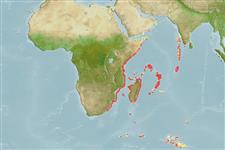Environment: milieu / climate zone / depth range / distribution range
Écologie
marin bathydémersal; profondeur 250 - 450 m (Ref. 6270). Deep-water
Western Indian Ocean: Kenya to Natal, South Africa. Unconfirmed record from Taiwan (Ref. 9792).
Taille / Poids / Âge
Maturity: Lm ? range ? - ? cm
Max length : 15.0 cm TL mâle / non sexé; (Ref. 9792)
Épines dorsales (Total): 0; Rayons mous dorsaux (Total): 60-62; Épines anales 0; Rayons mous anaux: 51 - 54. Eyed side greyish brown; dorsal, anal and pectoral fins dusky to black; 2 dark blotches on caudal fin; blind side pale with dusky spots (Ref. 6270). Pectoral fin rays on ocular side 8-7, blind 7-10. Body depth, length 2.5-2.8 times the depth (Ref. 41434).
Feeds on small benthic animals (Ref. 9792).
Life cycle and mating behavior
Maturité | Reproduction | Frai | Œufs | Fécondité | Larves
Heemstra, P.C., 1986. Pleuronectidae. p. 863-865. In M.M. Smith and P.C. Heemstra (eds.) Smith's sea fishes. Springer-Verlag, Berlin. (Ref. 6270)
Statut dans la liste rouge de l'IUCN (Ref. 130435)
Menace pour l'homme
Harmless
Utilisations par l'homme
Pêcheries: sans intérêt
Plus d'informations
Noms communsSynonymesMétabolismePrédateursÉcotoxicologieReproductionMaturitéFraiRassemblement de ponteFéconditéŒufsDéveloppement de l'œuf
RéférencesAquacultureProfil d'aquacultureSouchesGénétiqueElectrophoresesHéritabilitéPathologiesTraitementNutrientsMass conversion
Outils
Articles particuliers
Télécharger en XML
Sources Internet
Estimates based on models
Preferred temperature (Ref.
123201): 11.5 - 14.7, mean 13 °C (based on 21 cells).
Phylogenetic diversity index (Ref.
82804): PD
50 = 0.5000 [Uniqueness, from 0.5 = low to 2.0 = high].
Bayesian length-weight: a=0.01995 (0.00906 - 0.04395), b=3.01 (2.83 - 3.19), in cm total length, based on all LWR estimates for this body shape (Ref.
93245).
Niveau trophique (Ref.
69278): 3.5 ±0.37 se; based on food items.
Résilience (Ref.
120179): Milieu, temps minimum de doublement de population : 1,4 à 4,4 années (Assuming tmax>3).
Fishing Vulnerability (Ref.
59153): Low vulnerability (10 of 100).
